A Comparative Analysis of Person-Centered and Psychoanalytic Theories
VerifiedAdded on 2022/11/09
|7
|1399
|152
Essay
AI Summary
This essay provides a comparative analysis of two prominent counseling theories: person-centered therapy and psychoanalysis. It begins by introducing the core principles and proponents of each theory, highlighting Carl Rogers' emphasis on self-actualization within a supportive environment in person-centered therapy and Sigmund Freud's focus on unconscious forces in psychoanalysis. The essay then delves into the practical application of each theory, examining techniques such as free association and dream analysis in psychoanalysis, contrasted with the emphasis on empathy, unconditional positive regard, and congruence in person-centered therapy. Furthermore, it discusses the roles of therapists, the client's experience, and the goals of each approach, with a concluding preference for person-centered therapy due to its emphasis on the inherent goodness of individuals and their capacity for self-directed growth. The essay references key literature to support its analysis, providing a comprehensive overview of these two influential theories within the field of counseling.
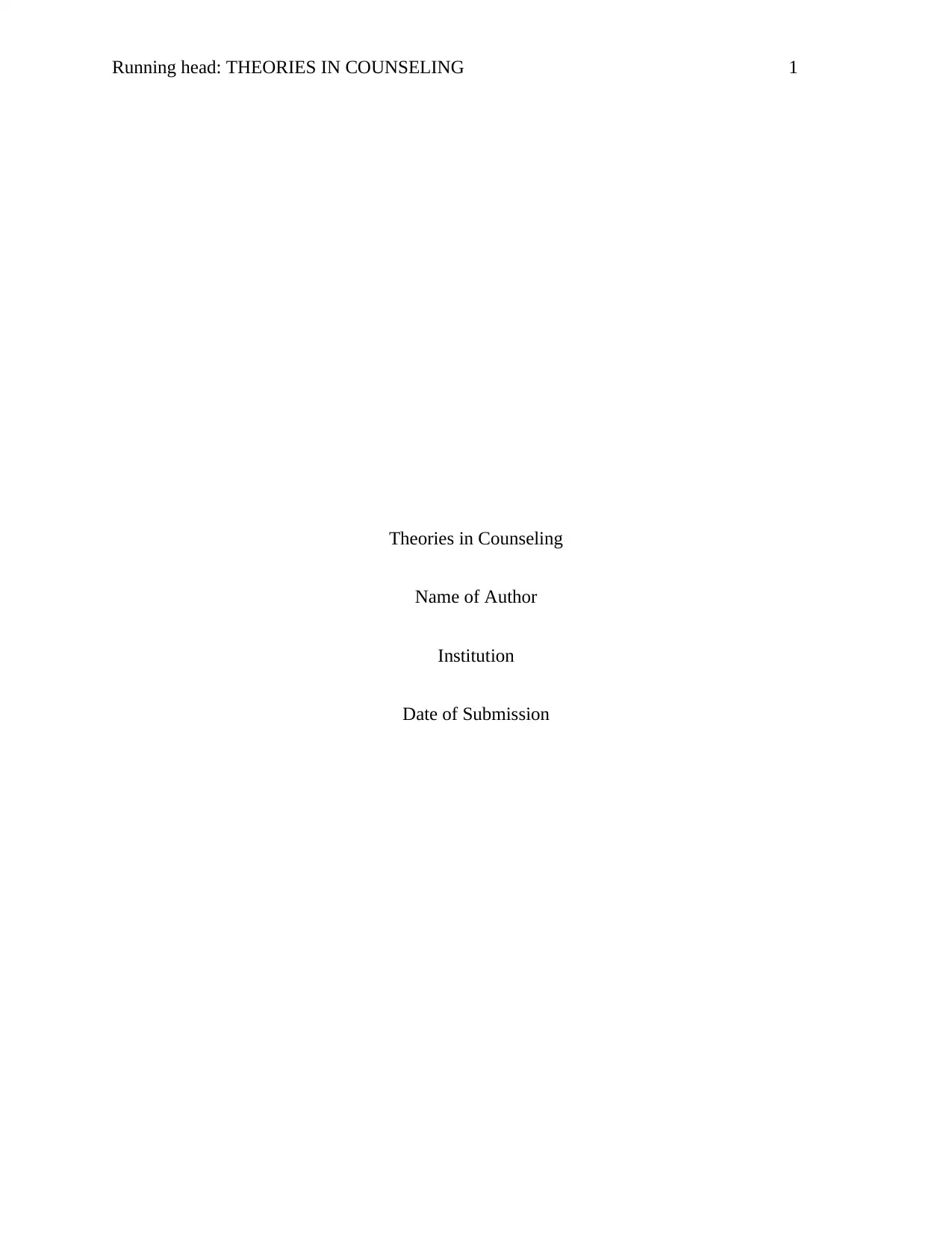
Running head: THEORIES IN COUNSELING 1
Theories in Counseling
Name of Author
Institution
Date of Submission
Theories in Counseling
Name of Author
Institution
Date of Submission
Paraphrase This Document
Need a fresh take? Get an instant paraphrase of this document with our AI Paraphraser
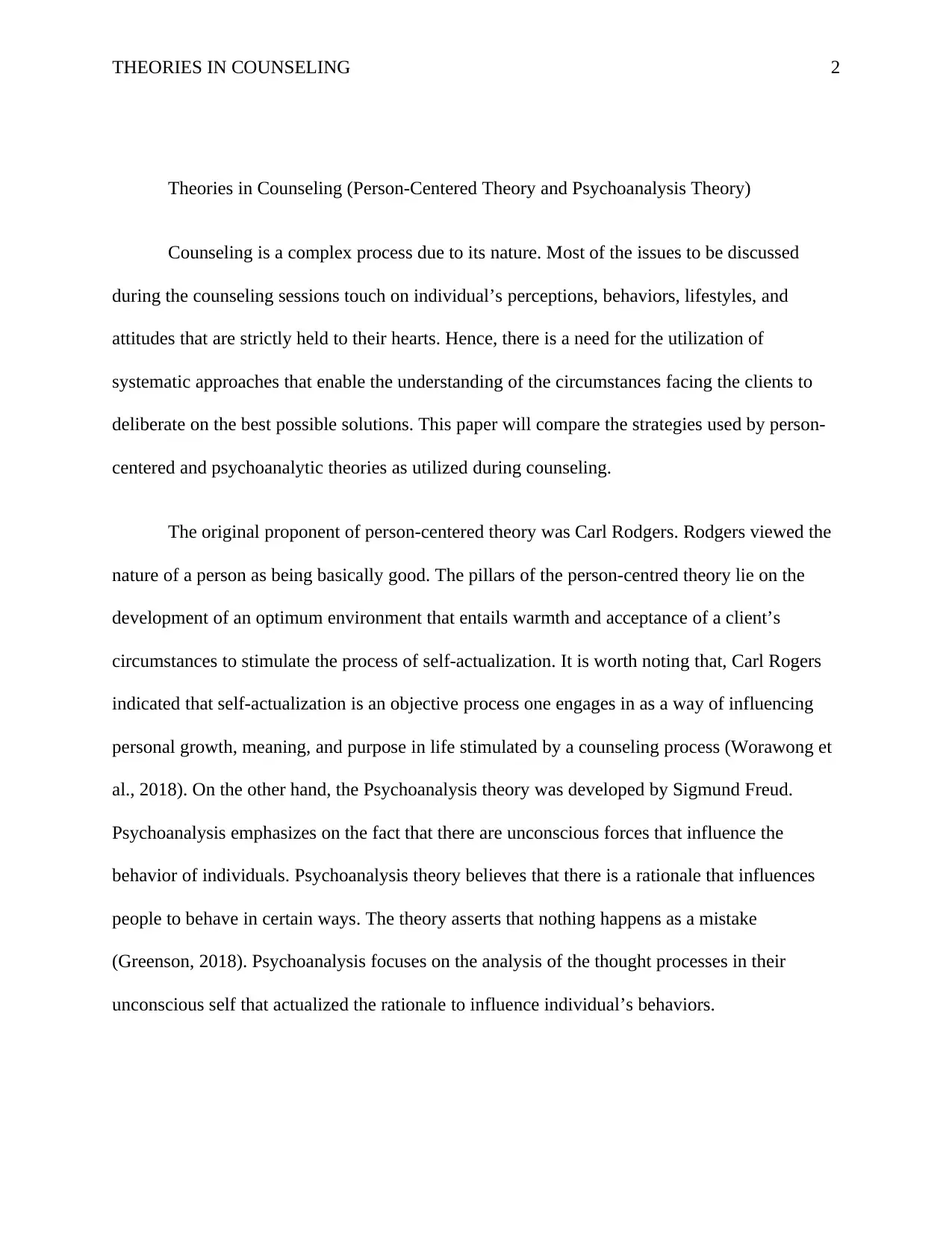
THEORIES IN COUNSELING 2
Theories in Counseling (Person-Centered Theory and Psychoanalysis Theory)
Counseling is a complex process due to its nature. Most of the issues to be discussed
during the counseling sessions touch on individual’s perceptions, behaviors, lifestyles, and
attitudes that are strictly held to their hearts. Hence, there is a need for the utilization of
systematic approaches that enable the understanding of the circumstances facing the clients to
deliberate on the best possible solutions. This paper will compare the strategies used by person-
centered and psychoanalytic theories as utilized during counseling.
The original proponent of person-centered theory was Carl Rodgers. Rodgers viewed the
nature of a person as being basically good. The pillars of the person-centred theory lie on the
development of an optimum environment that entails warmth and acceptance of a client’s
circumstances to stimulate the process of self-actualization. It is worth noting that, Carl Rogers
indicated that self-actualization is an objective process one engages in as a way of influencing
personal growth, meaning, and purpose in life stimulated by a counseling process (Worawong et
al., 2018). On the other hand, the Psychoanalysis theory was developed by Sigmund Freud.
Psychoanalysis emphasizes on the fact that there are unconscious forces that influence the
behavior of individuals. Psychoanalysis theory believes that there is a rationale that influences
people to behave in certain ways. The theory asserts that nothing happens as a mistake
(Greenson, 2018). Psychoanalysis focuses on the analysis of the thought processes in their
unconscious self that actualized the rationale to influence individual’s behaviors.
Theories in Counseling (Person-Centered Theory and Psychoanalysis Theory)
Counseling is a complex process due to its nature. Most of the issues to be discussed
during the counseling sessions touch on individual’s perceptions, behaviors, lifestyles, and
attitudes that are strictly held to their hearts. Hence, there is a need for the utilization of
systematic approaches that enable the understanding of the circumstances facing the clients to
deliberate on the best possible solutions. This paper will compare the strategies used by person-
centered and psychoanalytic theories as utilized during counseling.
The original proponent of person-centered theory was Carl Rodgers. Rodgers viewed the
nature of a person as being basically good. The pillars of the person-centred theory lie on the
development of an optimum environment that entails warmth and acceptance of a client’s
circumstances to stimulate the process of self-actualization. It is worth noting that, Carl Rogers
indicated that self-actualization is an objective process one engages in as a way of influencing
personal growth, meaning, and purpose in life stimulated by a counseling process (Worawong et
al., 2018). On the other hand, the Psychoanalysis theory was developed by Sigmund Freud.
Psychoanalysis emphasizes on the fact that there are unconscious forces that influence the
behavior of individuals. Psychoanalysis theory believes that there is a rationale that influences
people to behave in certain ways. The theory asserts that nothing happens as a mistake
(Greenson, 2018). Psychoanalysis focuses on the analysis of the thought processes in their
unconscious self that actualized the rationale to influence individual’s behaviors.
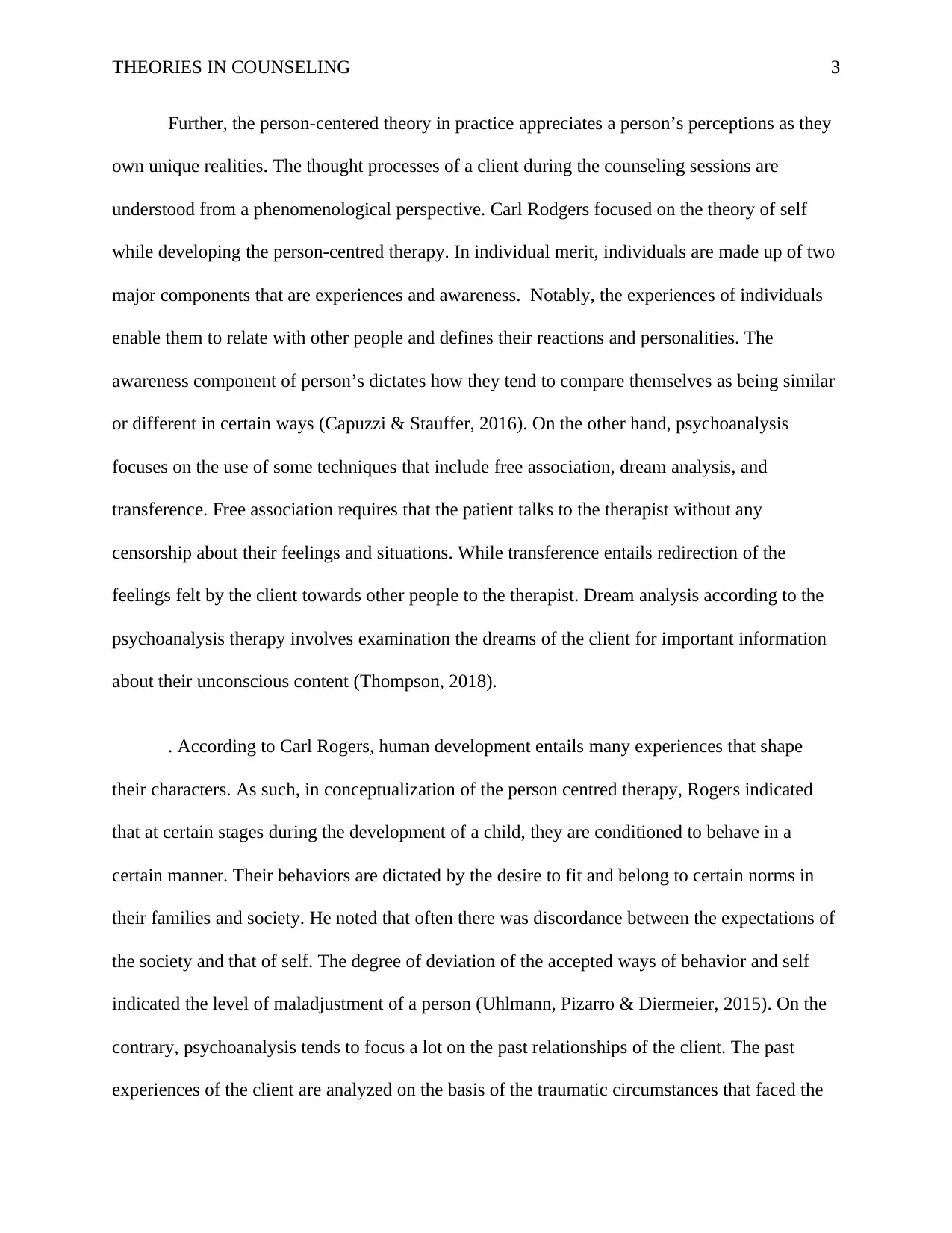
THEORIES IN COUNSELING 3
Further, the person-centered theory in practice appreciates a person’s perceptions as they
own unique realities. The thought processes of a client during the counseling sessions are
understood from a phenomenological perspective. Carl Rodgers focused on the theory of self
while developing the person-centred therapy. In individual merit, individuals are made up of two
major components that are experiences and awareness. Notably, the experiences of individuals
enable them to relate with other people and defines their reactions and personalities. The
awareness component of person’s dictates how they tend to compare themselves as being similar
or different in certain ways (Capuzzi & Stauffer, 2016). On the other hand, psychoanalysis
focuses on the use of some techniques that include free association, dream analysis, and
transference. Free association requires that the patient talks to the therapist without any
censorship about their feelings and situations. While transference entails redirection of the
feelings felt by the client towards other people to the therapist. Dream analysis according to the
psychoanalysis therapy involves examination the dreams of the client for important information
about their unconscious content (Thompson, 2018).
. According to Carl Rogers, human development entails many experiences that shape
their characters. As such, in conceptualization of the person centred therapy, Rogers indicated
that at certain stages during the development of a child, they are conditioned to behave in a
certain manner. Their behaviors are dictated by the desire to fit and belong to certain norms in
their families and society. He noted that often there was discordance between the expectations of
the society and that of self. The degree of deviation of the accepted ways of behavior and self
indicated the level of maladjustment of a person (Uhlmann, Pizarro & Diermeier, 2015). On the
contrary, psychoanalysis tends to focus a lot on the past relationships of the client. The past
experiences of the client are analyzed on the basis of the traumatic circumstances that faced the
Further, the person-centered theory in practice appreciates a person’s perceptions as they
own unique realities. The thought processes of a client during the counseling sessions are
understood from a phenomenological perspective. Carl Rodgers focused on the theory of self
while developing the person-centred therapy. In individual merit, individuals are made up of two
major components that are experiences and awareness. Notably, the experiences of individuals
enable them to relate with other people and defines their reactions and personalities. The
awareness component of person’s dictates how they tend to compare themselves as being similar
or different in certain ways (Capuzzi & Stauffer, 2016). On the other hand, psychoanalysis
focuses on the use of some techniques that include free association, dream analysis, and
transference. Free association requires that the patient talks to the therapist without any
censorship about their feelings and situations. While transference entails redirection of the
feelings felt by the client towards other people to the therapist. Dream analysis according to the
psychoanalysis therapy involves examination the dreams of the client for important information
about their unconscious content (Thompson, 2018).
. According to Carl Rogers, human development entails many experiences that shape
their characters. As such, in conceptualization of the person centred therapy, Rogers indicated
that at certain stages during the development of a child, they are conditioned to behave in a
certain manner. Their behaviors are dictated by the desire to fit and belong to certain norms in
their families and society. He noted that often there was discordance between the expectations of
the society and that of self. The degree of deviation of the accepted ways of behavior and self
indicated the level of maladjustment of a person (Uhlmann, Pizarro & Diermeier, 2015). On the
contrary, psychoanalysis tends to focus a lot on the past relationships of the client. The past
experiences of the client are analyzed on the basis of the traumatic circumstances that faced the
⊘ This is a preview!⊘
Do you want full access?
Subscribe today to unlock all pages.

Trusted by 1+ million students worldwide
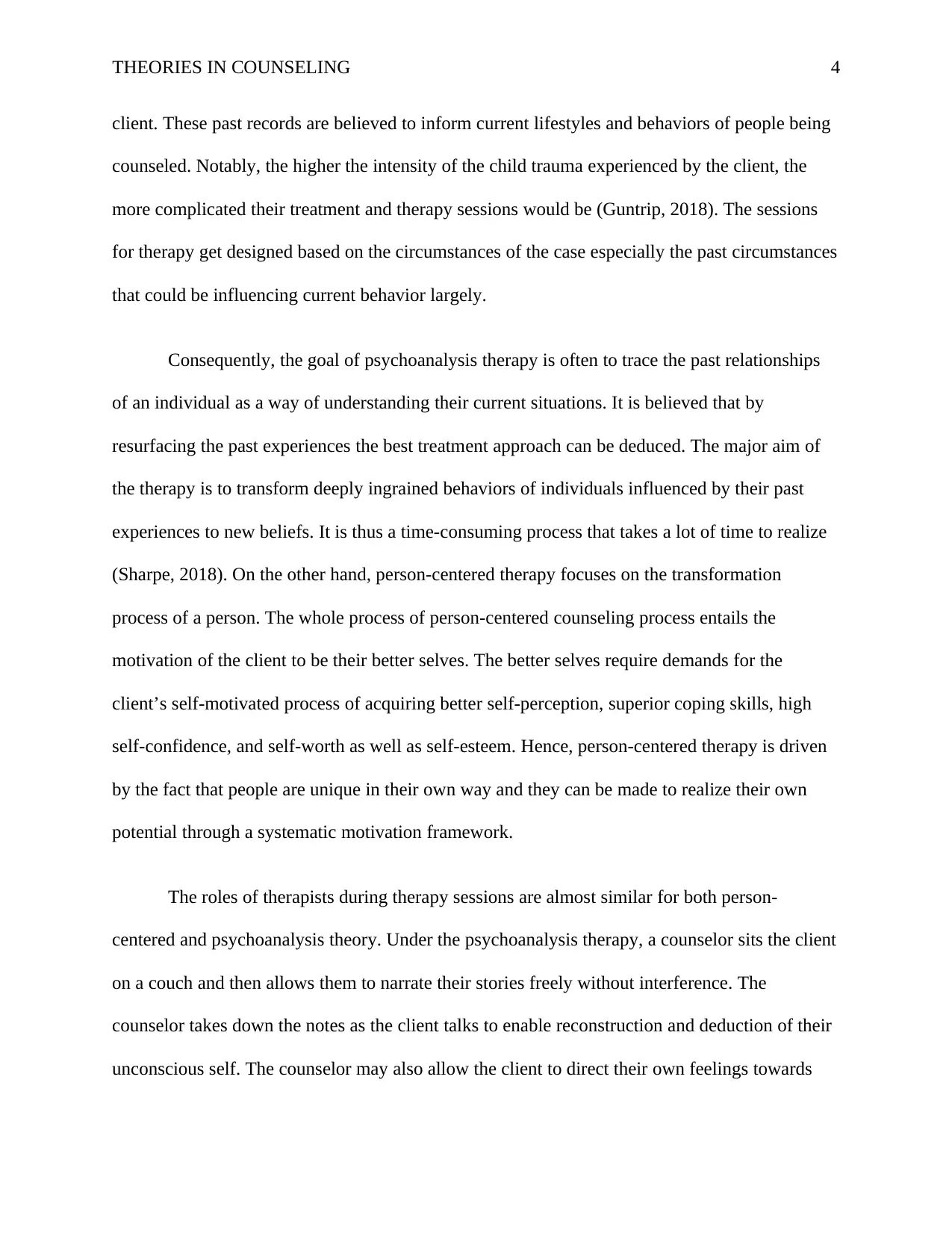
THEORIES IN COUNSELING 4
client. These past records are believed to inform current lifestyles and behaviors of people being
counseled. Notably, the higher the intensity of the child trauma experienced by the client, the
more complicated their treatment and therapy sessions would be (Guntrip, 2018). The sessions
for therapy get designed based on the circumstances of the case especially the past circumstances
that could be influencing current behavior largely.
Consequently, the goal of psychoanalysis therapy is often to trace the past relationships
of an individual as a way of understanding their current situations. It is believed that by
resurfacing the past experiences the best treatment approach can be deduced. The major aim of
the therapy is to transform deeply ingrained behaviors of individuals influenced by their past
experiences to new beliefs. It is thus a time-consuming process that takes a lot of time to realize
(Sharpe, 2018). On the other hand, person-centered therapy focuses on the transformation
process of a person. The whole process of person-centered counseling process entails the
motivation of the client to be their better selves. The better selves require demands for the
client’s self-motivated process of acquiring better self-perception, superior coping skills, high
self-confidence, and self-worth as well as self-esteem. Hence, person-centered therapy is driven
by the fact that people are unique in their own way and they can be made to realize their own
potential through a systematic motivation framework.
The roles of therapists during therapy sessions are almost similar for both person-
centered and psychoanalysis theory. Under the psychoanalysis therapy, a counselor sits the client
on a couch and then allows them to narrate their stories freely without interference. The
counselor takes down the notes as the client talks to enable reconstruction and deduction of their
unconscious self. The counselor may also allow the client to direct their own feelings towards
client. These past records are believed to inform current lifestyles and behaviors of people being
counseled. Notably, the higher the intensity of the child trauma experienced by the client, the
more complicated their treatment and therapy sessions would be (Guntrip, 2018). The sessions
for therapy get designed based on the circumstances of the case especially the past circumstances
that could be influencing current behavior largely.
Consequently, the goal of psychoanalysis therapy is often to trace the past relationships
of an individual as a way of understanding their current situations. It is believed that by
resurfacing the past experiences the best treatment approach can be deduced. The major aim of
the therapy is to transform deeply ingrained behaviors of individuals influenced by their past
experiences to new beliefs. It is thus a time-consuming process that takes a lot of time to realize
(Sharpe, 2018). On the other hand, person-centered therapy focuses on the transformation
process of a person. The whole process of person-centered counseling process entails the
motivation of the client to be their better selves. The better selves require demands for the
client’s self-motivated process of acquiring better self-perception, superior coping skills, high
self-confidence, and self-worth as well as self-esteem. Hence, person-centered therapy is driven
by the fact that people are unique in their own way and they can be made to realize their own
potential through a systematic motivation framework.
The roles of therapists during therapy sessions are almost similar for both person-
centered and psychoanalysis theory. Under the psychoanalysis therapy, a counselor sits the client
on a couch and then allows them to narrate their stories freely without interference. The
counselor takes down the notes as the client talks to enable reconstruction and deduction of their
unconscious self. The counselor may also allow the client to direct their own feelings towards
Paraphrase This Document
Need a fresh take? Get an instant paraphrase of this document with our AI Paraphraser
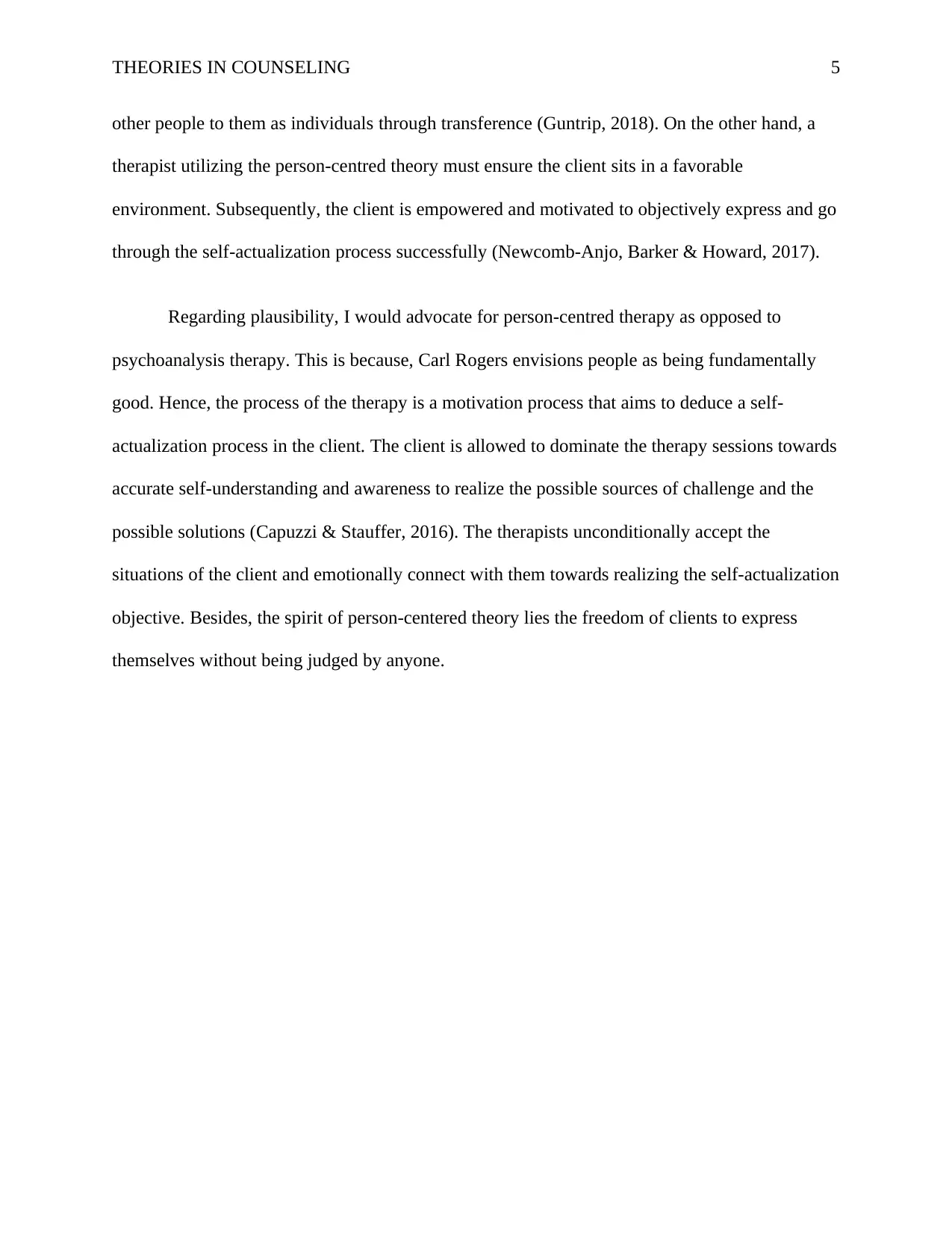
THEORIES IN COUNSELING 5
other people to them as individuals through transference (Guntrip, 2018). On the other hand, a
therapist utilizing the person-centred theory must ensure the client sits in a favorable
environment. Subsequently, the client is empowered and motivated to objectively express and go
through the self-actualization process successfully (Newcomb-Anjo, Barker & Howard, 2017).
Regarding plausibility, I would advocate for person-centred therapy as opposed to
psychoanalysis therapy. This is because, Carl Rogers envisions people as being fundamentally
good. Hence, the process of the therapy is a motivation process that aims to deduce a self-
actualization process in the client. The client is allowed to dominate the therapy sessions towards
accurate self-understanding and awareness to realize the possible sources of challenge and the
possible solutions (Capuzzi & Stauffer, 2016). The therapists unconditionally accept the
situations of the client and emotionally connect with them towards realizing the self-actualization
objective. Besides, the spirit of person-centered theory lies the freedom of clients to express
themselves without being judged by anyone.
other people to them as individuals through transference (Guntrip, 2018). On the other hand, a
therapist utilizing the person-centred theory must ensure the client sits in a favorable
environment. Subsequently, the client is empowered and motivated to objectively express and go
through the self-actualization process successfully (Newcomb-Anjo, Barker & Howard, 2017).
Regarding plausibility, I would advocate for person-centred therapy as opposed to
psychoanalysis therapy. This is because, Carl Rogers envisions people as being fundamentally
good. Hence, the process of the therapy is a motivation process that aims to deduce a self-
actualization process in the client. The client is allowed to dominate the therapy sessions towards
accurate self-understanding and awareness to realize the possible sources of challenge and the
possible solutions (Capuzzi & Stauffer, 2016). The therapists unconditionally accept the
situations of the client and emotionally connect with them towards realizing the self-actualization
objective. Besides, the spirit of person-centered theory lies the freedom of clients to express
themselves without being judged by anyone.
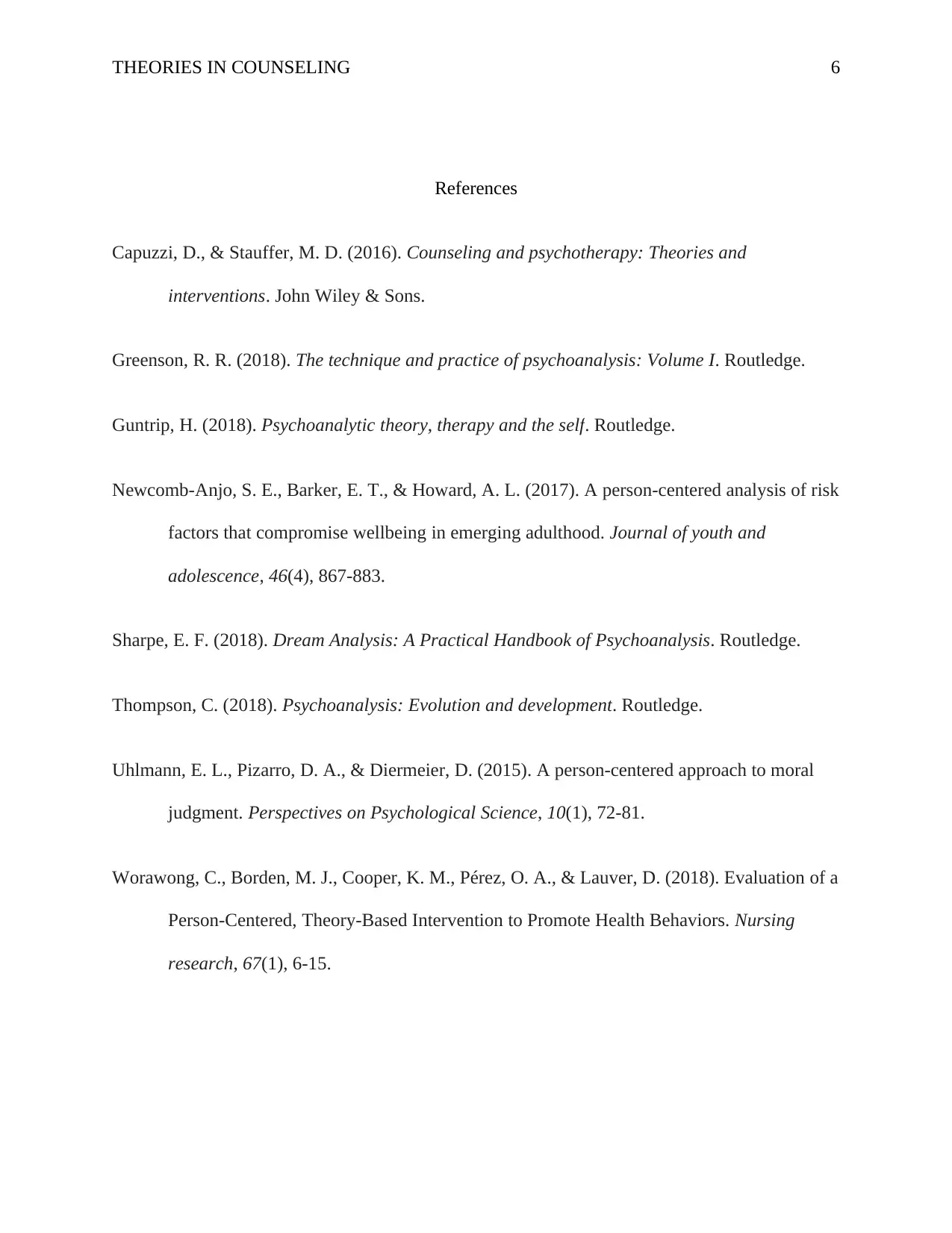
THEORIES IN COUNSELING 6
References
Capuzzi, D., & Stauffer, M. D. (2016). Counseling and psychotherapy: Theories and
interventions. John Wiley & Sons.
Greenson, R. R. (2018). The technique and practice of psychoanalysis: Volume I. Routledge.
Guntrip, H. (2018). Psychoanalytic theory, therapy and the self. Routledge.
Newcomb-Anjo, S. E., Barker, E. T., & Howard, A. L. (2017). A person-centered analysis of risk
factors that compromise wellbeing in emerging adulthood. Journal of youth and
adolescence, 46(4), 867-883.
Sharpe, E. F. (2018). Dream Analysis: A Practical Handbook of Psychoanalysis. Routledge.
Thompson, C. (2018). Psychoanalysis: Evolution and development. Routledge.
Uhlmann, E. L., Pizarro, D. A., & Diermeier, D. (2015). A person-centered approach to moral
judgment. Perspectives on Psychological Science, 10(1), 72-81.
Worawong, C., Borden, M. J., Cooper, K. M., Pérez, O. A., & Lauver, D. (2018). Evaluation of a
Person-Centered, Theory-Based Intervention to Promote Health Behaviors. Nursing
research, 67(1), 6-15.
References
Capuzzi, D., & Stauffer, M. D. (2016). Counseling and psychotherapy: Theories and
interventions. John Wiley & Sons.
Greenson, R. R. (2018). The technique and practice of psychoanalysis: Volume I. Routledge.
Guntrip, H. (2018). Psychoanalytic theory, therapy and the self. Routledge.
Newcomb-Anjo, S. E., Barker, E. T., & Howard, A. L. (2017). A person-centered analysis of risk
factors that compromise wellbeing in emerging adulthood. Journal of youth and
adolescence, 46(4), 867-883.
Sharpe, E. F. (2018). Dream Analysis: A Practical Handbook of Psychoanalysis. Routledge.
Thompson, C. (2018). Psychoanalysis: Evolution and development. Routledge.
Uhlmann, E. L., Pizarro, D. A., & Diermeier, D. (2015). A person-centered approach to moral
judgment. Perspectives on Psychological Science, 10(1), 72-81.
Worawong, C., Borden, M. J., Cooper, K. M., Pérez, O. A., & Lauver, D. (2018). Evaluation of a
Person-Centered, Theory-Based Intervention to Promote Health Behaviors. Nursing
research, 67(1), 6-15.
⊘ This is a preview!⊘
Do you want full access?
Subscribe today to unlock all pages.

Trusted by 1+ million students worldwide

THEORIES IN COUNSELING 7
1 out of 7
Related Documents
Your All-in-One AI-Powered Toolkit for Academic Success.
+13062052269
info@desklib.com
Available 24*7 on WhatsApp / Email
![[object Object]](/_next/static/media/star-bottom.7253800d.svg)
Unlock your academic potential
Copyright © 2020–2025 A2Z Services. All Rights Reserved. Developed and managed by ZUCOL.





